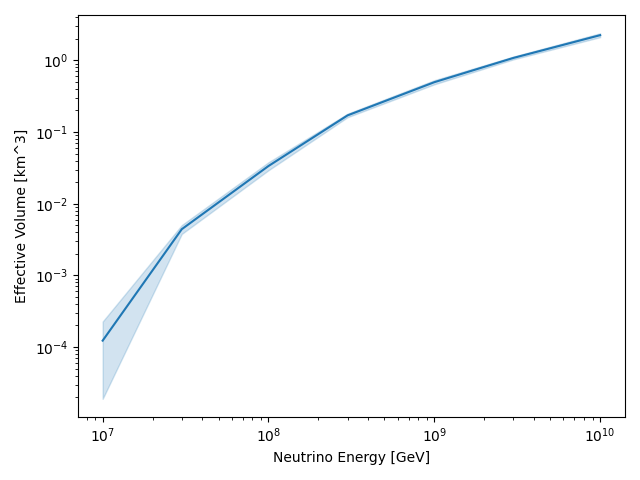Combine Effective Volume Simulations¶
In this example we will illustrate a set of files with effective volume data can be combined to produce a high-statistics effective volume curve. This code can be found in the combining_simulations.py script in the examples directory. A typical set of arguments for the script might look like the following:
python combining_simulations.py /path/to/output/directory/ ara02_ENERGY_INDEX.h5
Warning
This script is intended to be run on the files output by the script in the previous example, Distributed Effective Volume Simulation.
"""A script for combining the outputs of multiple effective volume simulations"""
import argparse
import os, os.path
import re
import numpy as np
import matplotlib.pyplot as plt
import pyrex
parser = argparse.ArgumentParser(description=__doc__)
parser.add_argument('directory',
help="directory containing simulation output files")
parser.add_argument('filename_pattern',
help=("pattern of file names to use, where 'ENERGY' will "+
"be replaced by the GeV energy in scientific "+
"notation (e.g. '1e9') and 'INDEX' will be replaced "+
"an incrementing index"))
args = parser.parse_args()
# Get a list of all of the files to read in
files = []
energies = []
full_pattern = re.compile(args.filename_pattern.replace("ENERGY", ".*").replace("INDEX", ".*"))
for filename in sorted(os.listdir(args.directory)):
if full_pattern.match(filename):
files.append(filename)
e_start = args.filename_pattern.index("ENERGY")
e_stop = -len(filename[e_start:].lstrip("1234567890e"))
energy = filename[e_start:e_stop]
if energy not in energies:
energies.append(energy)
energies.sort(key=lambda e: float(e))
# Iterate over the files of each energy, calculating the total effective volume
veffs = []
veff_errs = []
for energy in energies:
energy_pattern = re.compile(args.filename_pattern.replace("ENERGY", energy).replace("INDEX", ".*"))
energy_veffs = []
energy_veff_errs = []
for filename in files:
if energy_pattern.match(filename):
with pyrex.File(os.path.join(args.directory, filename)) as file:
energy_veffs.append(file['effective_volume'][0][0])
energy_veff_errs.append(file['effective_volume'][0][1])
# Note that averaging the effective volumes like this is only valid when
# each file (in a given energy) has the same number of events thrown as
# well as the same generation volume. If these conditions aren't met, each
# event in the files would need to be iterated in order to calculate the
# effective volume for the files as a whole.
veffs.append(np.mean(energy_veffs))
veff_errs.append(np.sqrt(np.sum(np.array(energy_veff_errs)**2))/len(energy_veff_errs))
energies = np.array([float(e) for e in energies])
veffs = np.array(veffs)/1e9
veff_errs = np.array(veff_errs)/1e9
print("Energy [GeV] \tVeff [km^3] \tError [km^3]")
for energy, veff, err in zip(energies, veffs, veff_errs):
print(f"{energy:.0e} \t{veff:.5e} \t{err:.5e}")
plt.loglog(energies, veffs)
plt.fill_between(energies, [v-e for v, e in zip(veffs, veff_errs)],
[v+e for v, e in zip(veffs, veff_errs)],
color='C0', alpha=0.2)
plt.xlabel("Neutrino Energy [GeV]")
plt.ylabel("Effective Volume [km^3]")
plt.tight_layout()
plt.show()

